Syracuse China patterns are earthy, elegant, and very artistic. Those Old plates and kitchenware that your grandparent’s or parents only bring out for special occasions are probably worth a few or plenty of bucks.
A Qing Dynasty fine China was purchased for $84 million by a wealthy businessman. This price makes it the most expensive fine China has ever sold in history.
This article is a collection of all the necessary information you need on these valuable wares. We have answers to every question you may have about Syracuse, including their origin, value, and how to identify them properly.
Table of Contents
A Brief History of Syracuse China Patterns
W.H Farrar started his journey to pottery excellence in 1841 when he began a small business producing pottery in Geddes, a small town in New York. Seventeen years later, he moved this little business to the location known as Syracuse, China, today.
Initially, Farrar manufactured jugs, butter crocks, and mixing bowls made from stoneware. The production didn’t go far as the Empire Pottery Company took over the production process, and they introduced a range of Whiteware for table use. Still, they were not durable and cracked easily.
After a failed attempt by the previous management, the Onondaga Pottery Company took over. Due to the high demand for finer ceramic ware, Onondaga produced earthenware for dining tables and toilets, making little to no progress.
In 1873, they ventured into producing Graniteware, an ironstone China and a spotted form of earthenware, and a partially vitreous ware in 1885, which was liquid friendly and suitable for dining table use.
Eventually, in 1886, the company began producing fine glazed China and found a large clientele in hotels, restaurants, and railroad diners. They began marking the pieces with Syracuse China in 1895.
Syracuse company pioneered the production of heavily decorated and high-quality China in the United States, guaranteeing that it would neither crack nor age by adopting a chip preventing technology in 1896. This innovation solidified Syracuse’s place in the market.
Syracuse was popular for making fine China plates and patterns until the early 1970s when it focused solely on dinnerware for high-end restaurants and eventually changed its name to SYRACUSE CHINA in 1996 to coordinate with its back stamp at that time.
The company closed production laid off 200+ employees and all members of the Glass, Molders, Pottery, and Allied workers international union in 2009 after almost a decade run of excellence.
Syracuse gave each employee a celebratory piece with a collage of images showing the company’s transition and its eight stamps used throughout its journey. On the face of the plate, the words “Though the world may change around us; our history remains the same”
The 38-A mark was inscribed at the back of each ware to indicate the final piece of China produced in Syracuse. The 38 is a code representing the production year (1971), and the letter A represents the month of production.
You can find most of the records and Chinaware in the Onondaga Historical Association. Syracuse, china, did the keeping ensuring the proper preservation of a very historical era in the history of Syracuse, New York, and America at large.
How to Identify Syracuse China Patterns
It can get confusing to identify Syracuse patterns at first look due to the recurring dates, figures, and letters. We have collated ways by which you can make this process easy as ABC.
Identification by shape
Yes, you can identify your vintage Syracuse patterns through their shapes and outline. Check below for categories of forms available.
Year |
Shapes |
1873 |
Cable, Empire |
1879 |
Square |
1887 |
Doris, Grecian |
1888 |
Juno |
1891 |
Imperial Gedo |
1892 |
Fork Handle Square |
1896 |
Rounded |
1915 |
Empire |
1922-1935 |
Governor Winthrop |
1928-1952 |
Winchester |
1932-1933 |
Clinton |
1933 |
Econo-Rim |
1937-1942 |
Shelledge |
1937-1970 |
Virginia |
1949 |
Winthrop |
1950 |
Berkeley |
1953 |
Essex |
1955 |
Trend |
1957 |
Carefree |
1961 |
Silhouette |
1966 |
Tudor |
1968 |
Calypso, California, Wellington |
1975 |
Signet |
1978 |
Gibraltar |
1988 |
Chateau (Canadian), Parliament (Canadian) |
1989 |
Tremont, Verona, Belmont |
1990 |
Castleton |
1993 |
Justine |
1995 |
Barista |
1996 |
Cantina |
Other shapes include Mayflower, Morwell, Syrene, Oneida, savoy, Turina, Marmora, Puritan, Rolled edge, American, Olympus and Doric, A la Carte.
Identification by date codes
Date codes on Syracuse patterns help provide accurate information on the month and year in which a particular China emerged. The makers of Syracuse used this golden innovation to preserve their history somewhat and organize distribution. Check this chart for context.
Identification by their names
You can find these names on the body of your Syracuse China, Canterbury, Old Ivory, Nature study, Old Cathay, Palomino, Key Biscayne, Golden Maize, Harmony, and Superior China.
If you come across the following names beneath your plate, you have a Syracuse ware in your possession.
How to Determine the Value of Syracuse China
Here are a few key factors you must consider when purchasing, collecting, or selling off your Syracuse Chinaware. These important pointers will help you get the correct value for your money and prevent you from purchasing inferior wares.
Age
Old and earliest models of Syracuse China tell stories of years and years of transition and modifications by the company. Bagging of these old pieces will put you on every Collector and buyer’s hotlist.
Condition
Your ware is only truly appreciated if it comes in a whole and complete condition. No one wants to waste a fortune of money on chipped, faded, or broken dishes. So, take extra care of your China if you’re going to make the most of it.
Rarity
Rare pieces with distinctive shapes, designs, and features like the OLD IVORY (the first colored Syracuse Chinaware) and the ECONO-RIM (a slim-bodied China perfect for small tablespaces) are highly sought after by collectors and buyers.
Online stores and collector’s websites
Since Syracuse has ended production permanently, getting information as regards the true value of their wares may be a bit difficult. Consult auction websites, online stores, and Collector’s profiles to know the exact worth of your Syracuse wares.
How to Date Syracuse China
Here’s a guide on identifying your Syracuse China using their years and back stamps. The Syracuse company applied a few modifications to their products with each passing year. Hence the slight difference you’ll discover as you read this article.
The first and most important tip you need to date your Syracuse China successfully is a prop knowledge of the back stamps inscribed on these wares. These back stamps will help you determine the period they produced the wares.

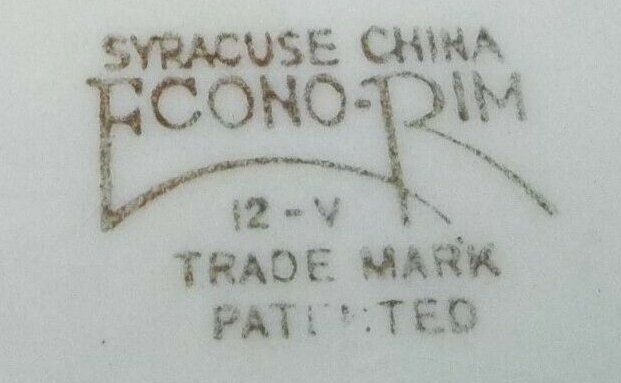
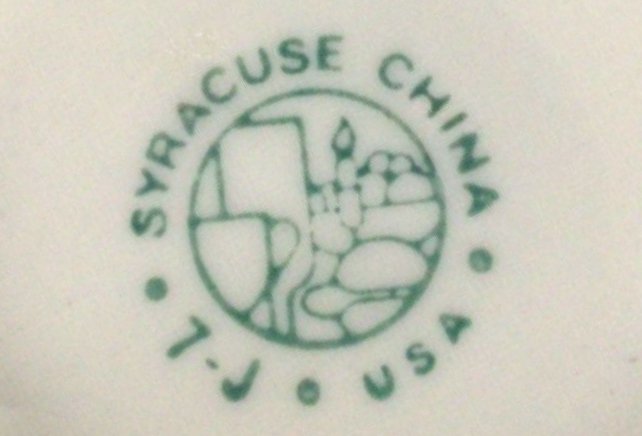
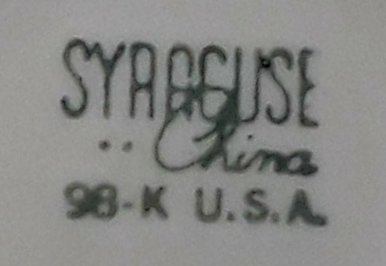
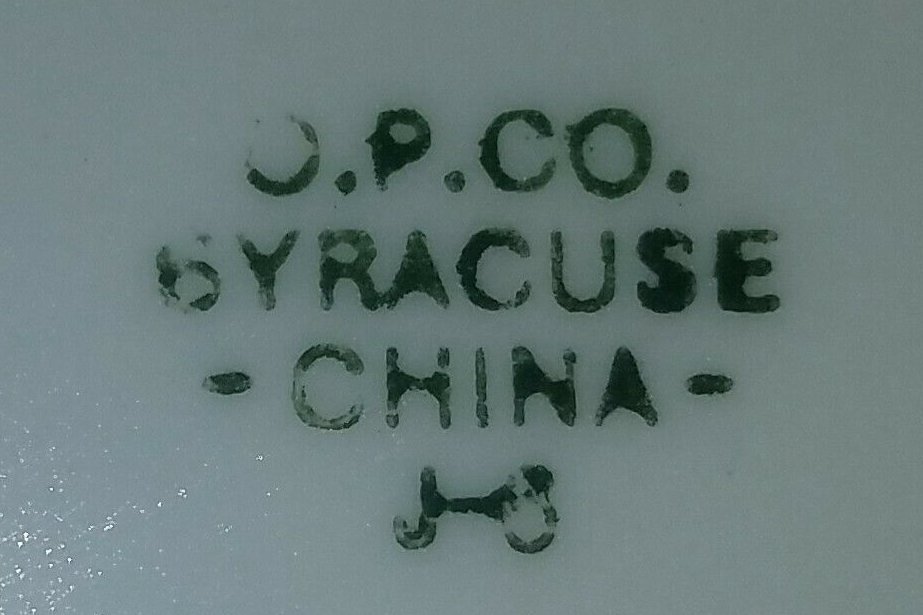


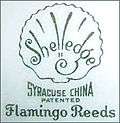
- 1885-1890: Wares made within this period have the O.P.Co mark with a broken line right under the CHINA word.
- 1890-1895: You’ll find the O.P.Co with a thick line under the 1890-1895 wares. The word CHINA is also boldly written.
- 1895-1897: If you have a piece from this period, you’ll find the phrase Syracuse China O.P.Co inscribed in a circle.
- Wares made between 1897-1926 had the stamps O.P.Co Syracuse China inscribed boldly on their bodies.
- 1920-1946: O.P.Co Syracuse China with date codes appeared on the bodies of the pieces.
- 1927-1960: The Old Ivory phrase sits on the body of the first colored Chinaware made during this period.
- 1932-1972: wares produced during this period had the Adobe Ware marks on them.
- 1933-1967: Econo Rim back stamps are on the pieces made this year. This model had an ultra-slim body perfect for the narrow table space of dining vans.
- 1959-1974: Syracuse China of Canada.
- 1968-2009: Syracuse China Made in America/ USA.
Another way to correctly confirm the date of your Syracuse China is to observe how the code sits on their bodies. If the mark immerses into the body of the ware, then the Syracuse company produced it years before 1920.
If you have a China with marks stamped in ink on their bodies, then you have a post-1920 Syracuse piece in your hands. Codes placed in circles are inscribed on pre-1911 wares, while codes in diamonds are on wares produced after 1911.
Syracuse China Date Codes
It can get interesting but confusing to identify Syracuse date codes at first look due to the recurring figures and letters.
This table contains in detail the codes used on Syracuse pieces at various periods of production till they rounded up.
- 1895 (May to December) represented by numbers 1-6.
- 1896-1902 (January to December) represented by numbers 9-92.
- 1903 (January through June) represented by numbers 93-98.
- 1903 (July, August, September) represented by numbers 99.
- 1903 (October, November, December) represented by numbers 1-3 in a circle (code is stamped).
- 1904-1911 (January to December) represented by numbers 4-99 in a circle (code is stamped).
- 1912-1919 (January to December) represented by numbers 1-99 in a diamond (code is stamped).
1920 through 1960: Various company mark trademarks set underglaze with pigment. Format: Year (represented by a letter(s)) – Month represented by numbers 1 through 12.
From 1923, Syracuse began distinguishing China made at their two different factories by order of the numbers:
Fayette Street Plant: YY-1 (year-month).
Court Street Plant: 1-YY (month – year).
(Few sources say this alteration happened in 1930.)
1920 |
A |
1921 |
B |
1922 |
C |
1923 |
D |
1924 |
E |
1925 |
F |
1926 |
G |
1927 |
H |
1928 |
I |
1929 |
J |
1930 |
K |
1931 |
L |
1932 |
M |
1933 |
N |
1934 |
O |
1935 |
P |
1936 |
Q |
1937 |
R |
1938 |
S |
1939 |
T |
1940 |
U |
1941 |
V |
1942 |
W |
1943 |
X |
1944 |
Y |
1945 |
Z |
1946 |
A |
1947 |
B. B |
1948 |
CC |
1949 |
D |
1950 |
E.E. |
1951 |
F |
1952 |
G |
1953 |
H.H |
1954 |
II |
1955 |
J |
1956 |
K.K. |
1957 |
L.L. |
1958 |
MM |
1959 |
N.N. |
1960– January only |
O.O. |
1960 through 1962: By the logo’s base is a dotted row. The placement of the missing dot signifies the production month. A two-digit number marks a year (number of years since 1871 when O.P. Co commenced operation).
A famous industrial designer named Peter Piening created a logo which the company used very briefly on the backstamp in 1962.
1960– February to December |
89 (month indicated by a missing dot). |
1961– January to December |
90 (month indicated by a missing dot). |
1962– January to June |
91 (month indicated by a missing dot). |
1962 to Today: Various company mark trademarks put underglaze with color. Format: year indicated as year number (counted from 1871). After 1975, the year was described as a year since 1971).
1962– July to December |
91 (Month is specified by letters G to L). |
1963 |
92 (Month is identified by letters A through L). |
1964 |
93 (Month is identified by letters A through L). |
1965 |
94 (Month is specified by letters A through L). |
1966 |
95 (Month is defined by letters A through L). |
1967 |
96 (Month is identified by letters A through L). |
1968 |
97 (Month is identified by letters A through L). |
1969 |
98 (Month is identified by letters A through L). |
1970 |
99 (Month is identified by letters A through L). |
1971 |
100 (Month indicated by letters A through L). |
1972 |
101 (Month indicated by letters A through L). |
1973 |
102 (Month indicated by letters A through L). |
1974 |
103 (Month indicated by letters A through L). |
1975 |
4 (Month is by letters A through L). |
1976 |
5 (Month is specified by letters A through I) (Letter codes used for more than one month). |
1977 |
6 (Letter codes used for more than one month). |
1978 |
7 (Letter codes used for more than one month). |
1979 |
8 (Letter codes used for more than one month). |
1980 |
9 (Letter codes used for more than one month). |
1981 |
10 (Letter codes used for more than one month). |
1982 |
11 (Letter codes used for more than one month). |
1983 |
12 (Letter codes used for more than one month). |
1984 |
13 (Letter codes used for more than one month). |
1985 |
14 (Letter codes used for more than one month). |
1986 |
15 (Letters A-D show a quarter of the year). |
1987 |
16 (Letters A-D show a quarter of the year). |
1988 |
17 (Letters A-D show a quarter of the year). |
1989 |
18 (Letters A-D show a quarter of the year). |
1990 |
19 (Letters A-D show a quarter of the year). |
1991 |
20 (Letters A-D show a quarter of the year). |
1992 |
21 (Letters A-D show a quarter of the year). |
1993 |
22 (Letters A-D show a quarter of the year). |
1994 |
23 (Letters A-D show a quarter of the year). |
1995 |
24 (Letters A-D show a quarter of the year). |
1996 |
25 (Letters A-D show a quarter of the year). |
1997 |
26 (Letters A-D show a quarter of the year). |
1998 |
27 (Letters A-D show a quarter of the year). |
FAQs
Where can I buy Syracuse China?
You can purchase these pieces on auction websites, at the estate and yard sales, online antique websites, and flea markets.
Who makes Syracuse China?
The Onondaga company manufactures Syracuse China. It was initially known as the Farrah pottery company located in Geddes, New York.
Why did the Syracuse China Corporation end production?
The Libbey company of Ohio, who had taken over the company at that period, ended production and laid off all staff after a century run to cut expenditure and relocated from North America.
Where was Syracuse China made?
Syracuse China Wares came from in the town of Geddes, New York.
Parting Words
Now that you know the true value and worth of that Syracuse China lying idle in your kitchen from the detailed article above, you should take note of the important points below if you plan on collecting more or selling the ones in your possession.
- Syracuse was the first American-based company to produce durable and high-quality China.
- You can identify your China via backstamps and the date code table provided above.
- Syracuse China models like the Old Ivory and Econo Rim are rare and highly collectible. If you have one, guard it closely.


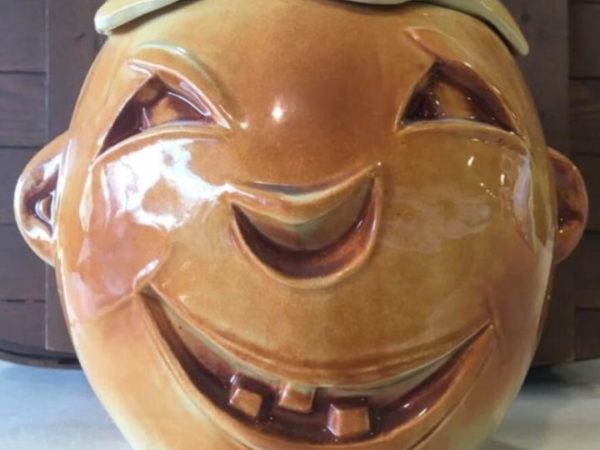



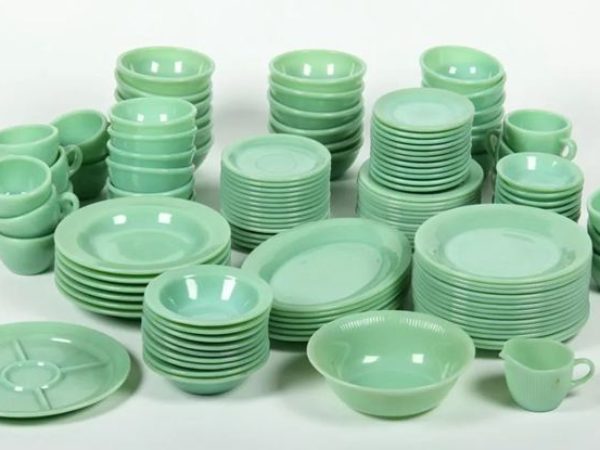
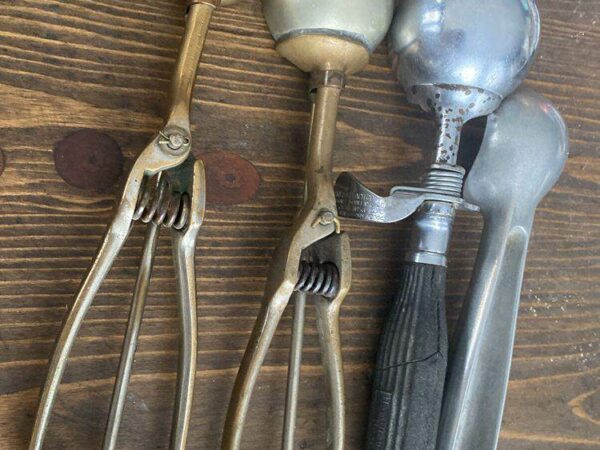

This article was very helpful tome. I believe I have a 1962 Feb.
I call the pattern Mobil’s, not sure of the real name.
I have a 12” platter with 91-C the second dot missing.
I would like to send a picture to confirm.
Thank you,
Teresa Smith